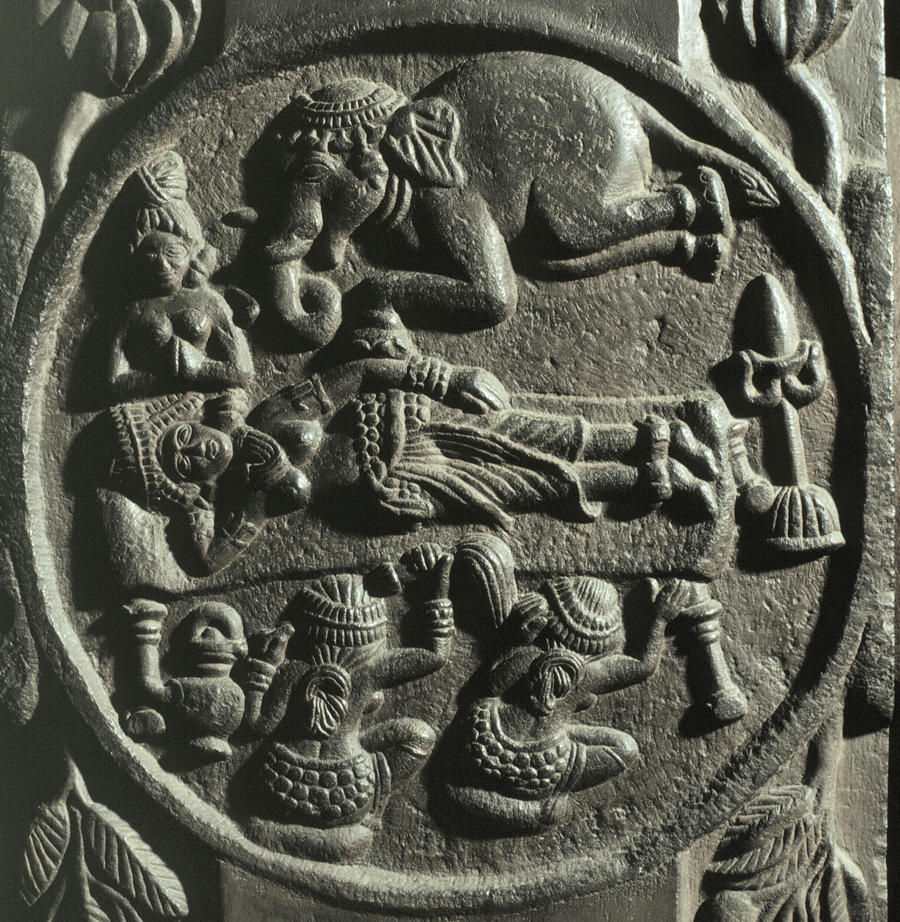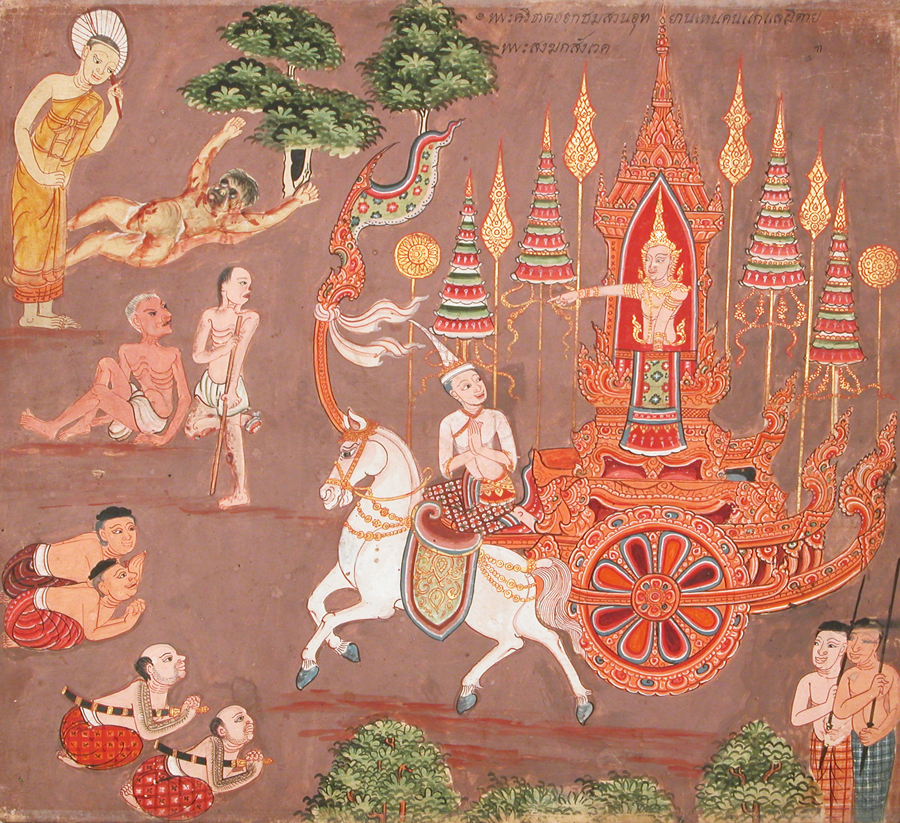Buddhism is unquestionably one of the world’s major faith traditions, but its origins are somewhat shrouded in mythology and legend surrounding its founder, Siddharta Gautama, the historical Buddha. Who was he? When and where did he live? And what were the social currents and forces in his own time that shaped his worldview and led him to renounce the world in an effort to save humanity from itself?
Guest Keeley Sutton from UT’s Department of Asian Studies helps us understand the historical Buddha and the era in which he lived.
Guests
 M. Keely SuttonAssistant Professor of Religion at Birmingham-Southern College
M. Keely SuttonAssistant Professor of Religion at Birmingham-Southern College
Hosts
 Christopher RosePostdoctoral Fellow, Institute for Historical Studies, The University of Texas at Austin
Christopher RosePostdoctoral Fellow, Institute for Historical Studies, The University of Texas at Austin
![Buddha statue from the Gupta Period. "Buddha [India] (69.222)". In Heilbrunn Timeline of Art History. New York: The Metropolitan Museum of Art, 2000–. http://www.metmuseum.org/toah/works-of-art/69.222 (October 2006)](http://sites.utexas.edu/15minutehistory/files/2013/03/Buddha-from-the-Gupta-Period.jpg)
“Buddha [India] (69.222)”. In Heilbrunn Timeline of Art History. New York: The Metropolitan Museum of Art, 2000–. http://www.metmuseum.org/toah/works-of-art/69.222 (October 2006)
That’s a difficult question. Some people say that it’s a religion or a religious tradition; other people would maybe say that it’s more of a philosophy or a practice—something you practice more than something you believe, which is where there’s a disconnect between east and west.
When we talk about the development of Buddhism, what time period are we looking at, historically speaking?
Well, the dates of the historical Buddha, Siddharta Gautama, has been shifted around a bit over the years. I think that scholars are now looking at maybe 470, 480 BCE as an approximation of when he was born. He lived for 80 years, according to his biographies in some of the canons. So, that puts him at around 400 BCE when he passed away. Prior to this, they had dates a little earlier, in the 500s.
What was going on in India at the time? I believe that Karen Armstrong describes this period as the Axial Age. There was a lot of religious fervor with new movements springing up. What was going that was contributing to that?
Around that time period, you have some shifts in Brahmanical thought. Brahmanism is how early religion in India was talked about, the name given to it. That has some of the aspects of what still exists in Hinduism today, one of which is the caste system. You have Brahmins, Ksatriya, Vaisyas, and Sudras—it’s a four part caste system.
The Brahmins were the priests; Ksatriya were the rulers or kings; Vaisyas were the merchants or pastoralists, they were herders—they herded cattle, or they grew crops; and the Sudras, who were the servants. They were the bottom, and they weren’t allowed access to the ritual system. If you’re Vaisyas or Ksatriya, you could have Brahmins perform sacrifices for you. These sacrifices initially were for the normal kind of mundane things—long life, riches, having a son—and in the old literature, which are the Vedas, you see concerns for being reborn into heaven, even. There wasn’t an idea of rebirth like you see later.
But, when you get more towards the Buddha, toward the Axial age, something new was happening—an urbanization was going on. So, instead of having small kin groups, you have rulers who are ruling over several kin groups; you have the growth of cities, and with that you had people who were more settled and not moving around as much. Maybe they had surpluses, surplus of food, a surplus of money, things like that. So, people with surpluses have the ability to give it to people.
At the same time, you have these Sramana movements, which means ascetic, or renouncing, movements. This was happening within the Vedic / Brahmanical world as well. And at that time, that’s when you start seeing concepts such as Samsara, which is the wheel of birth and rebirth, this idea of being born and reborn back into the world. And the idea of karma, which originally meant “action” only in the ritual sphere, so when you talked about karma you were talking about how the Brahmin priests sacrificed—it was their sacrificial actions. Instead, this took on the new understanding that what you did in this world would affect how you were reborn. And then you start getting the idea too in the Upanishads, which are the later Vedic texts, of moksha—the idea is that you want to be reborn.
That you want to be able to control how you’re reborn…
…right! And actually get out of the system—release, moksha means release or liberation.
Where does the Buddha fit in to all of these developments?
He was within this whole sphere, so these ideas were probably floating around to a certain extent—the idea of Samsara, the idea of karma.And there was also the idea of Brahman. Brahman is the unchanging and highest reality that exists in and even beyond the world. Another concept that’s related is that of atman, which is the essence and true self of the individual. It’s perhaps loosely analogous to a soul.
Now, in the Upanishadic texts the big kind of “aha!” moment was when you realize that atman equals Brahman. So, Brahman—not the priests Brahmin, but Brahman the reality, what things really are. In the Upanishadic, the Vedic, the Brahminical sphere, the way to reach release was to realize that you are actually the Ultimate, Brahman. That is who you really are: your atman, your self, is Brahman.
Obviously, you and I would be released right now if it was just a intellectual understanding. But we’re talking about a really deep understanding that comes about after years of study and meditation. So that was key because atman in this system, the Brahminical system, equals Brahman.
Well, Buddha came in to this system—the Buddha, Siddharta Gautama—and what he ended up understanding is that there is no self. This was a major shift, from a self, a soul, your atman being Brahman—meaning that you have an eternal self—he said no, there’s no such thing as a self. So, he was clearly reacting to this.
Another way that he reacted to it of course was that he was very egalitarian. So instead of Brahmins being the people who were the conduit between the gods and the people, and also this rigid caste system in which where you were born is where you were, he said, “No, come one, come all,” basically. Women were eventually allowed into the system. It didn’t really matter what your caste was, as well.
Let’s talk a little bit about the Buddha’s personal biography—
Sure.
—Who he was, where he was, what his station was in life, and how he came to a religious life.
Biographies of the Buddha started being written a few hundred years after his death. One of the most famous ones is Asvaghosa‘s Buddhacarita, which means “A History of the Buddha.”
They say he was a prince. I think he said within some of the Pali Canon that he was a K?atriya, he would tell people that he was a Ksatriya. He definitely was of a ruling family. This particular story was already infused with the mythology of the Buddha. A lot of things happen that point forward to who he would become—
—right—

So, his mother, for instance had a vision of a white elephant entering her side. And then, later the story says that she was on her way to her family’s house to have the baby, which is customary, and she stopped at this particular grove, and she had the Buddha without pain, standing up. The Buddha was born fully aware, he took seven steps, and he spoke. So, that’s what the Buddhacarita says. It further goes on to talk about how he was—because of all of these auspicious things that happened around him—he went and spoke to some wise men or Brahmins and they said, “Well, your son will be a universal king, or he will be a really wise sage, a religious ascetic. He will renounce the world.”
Well, the king, his father, didn’t want him to become a renouncer, he wanted him to become a world king. The story says that he put him in a palace, and he made sure that he saw no suffering, nothing bad. And he was lavished with all of the sensory delights that you could imagine. Eventually, he got married at age 29, and he had a son. But, the gods had to intervene according to this story, and one day when he was out in the city, they sent certain things for him to see.
One of these was a sick person, one was a dead person, one was an old person, and finally, an ascetic—a renouncer—who was in saffron robes with a shaven head. The point of all this was that when he saw the first three, he realized that you cannot escape certain kinds of suffering. You can’t escape sickness, death, or old age. And these kind of tormented him. And when he saw the monk, he had to ask, “Who is that?” And when his charioteer told him, it started this thought process, I think, in his head.

And from that point, he left the palace—
—right—
—and began his religious journey—
—right—
What was his early … I don’t know if ministry is the right word to use in terms of the Buddha, but clearly he attracted followers. What was the impact of his small religious cult during his lifetime, or as far as we can tell?
We don’t really have a lot of evidence from that time. We have the Pali Canon, which wasn’t even written down until after his death, that’s the earliest text. We also have the Therigatha, which are songs of the elders, the men and the women. We know that, as I said before, you had these other renouncing movements. There were a lot of them going on, and you had Jainism going on as well. I don’t know – we know that it was patronized, obviously, but we don’t know how much it was even seen as a separate movement on the ground. People probably patronized a lot of different traditions. People would have the same kind of thing, they would come begging.
!["Buddha Amoghasiddhi with Eight Bodhisattvas [Tibet (Central regions)] (1991.74)". In Heilbrunn Timeline of Art History. New York: The Metropolitan Museum of Art, 2000–. http://www.metmuseum.org/toah/works-of-art/1991.74 (September 2008)](http://sites.utexas.edu/15minutehistory/files/2013/03/Buddha-and-Bodhisattvas.jpg)
The main kind of ideas are the Four Noble Truths, and you can kind of see it from the story, too—again, that was written after his death—
—right—
it’s all encompassed very nicely.
All life is suffering, first of all. And, this was something that was understood already in the milieu of Vedic thought anyway, it was just how you dealt with it that differed. By suffering, it doesn’t mean sharp, shooting pain. Maybe a better translation is “unsatisfactoriness.” So, in the Buddhist understanding, when we’re anxious about schoolwork or we’re anxious about work, or we’ve got the restless feeling, or we’re just a little sad, or we get something that want and then we realize that maybe that’s not what we wanted, or it’s not enough—you get what you want but then you realize that you’re happy for a day but then you’re back to where you were—all this is suffering. So, that’s the first tenet, or the first Noble Truth: all life is suffering.
The second Noble Truth is that suffering is caused by desire. So, because we want things and want to own them and have them, that’s what causes the suffering.
The third noble truth is that there is a way to stop suffering. He said, we can stop it. It’s not something that we have to live with.
And the fourth Noble Truth is the Eight-fold Path, which is his particular prescription. This is set up almost like something a doctor would do. He looks at the problem, he finds the root of it, he figures out whether or not it can be cured, and then he gives you the cure. So, this is the cure, the Noble Eight-fold Path.
Are there similarities between some of these concepts and some of those that we associate with Hinduism?
Well, you definitely have Samsara, which is the wheel of life and death and rebirth. You’ve got karma. Instead of atman, the Buddha said there’s no self, in fact one our our big fundamental problems is that we think that we exist, we think that we have a soul, but we really don’t. And that’s diametrically opposed to Brahminism. But, interestingly enough … the way that Buddhism dried up and left India is not totally clear, people point to a lot of different reasons, but one of the things that people do say is that after these Sramina movements of the Vedic world—of Brahminism—with these Upanishadic understandings, but then you also have later the Bhakti movements. Bhakti means devotion. And later you have these Bhakti movements growing throughout India and some people argue that Buddhism was kind of incorporated into some of these other movements. Some of the Bhakti movements, or even some of the Vedic movements–movements that are based on the Vedas.
As a matter of fact, vegetarianism, which a lot of people think actually started with Jainism, which started around the same time as the Buddha—Buddhism kind of adopted it, and then Hinduism adopted it.
Vishnu eventually incorporated the Buddha as his ninth avatar. So, the ten major avatars of Vishnu, which were written about later, took him as the ninth avatar.
You mention that the Buddha married and had a son…
… yes, Rahula, his name was, which means “binding.”
… was there any veneration of the family?
No.
So, we don’t really know what happened to the line of descendants after that?
No, we sure don’t. At least not as far as I know.
He always said that the important thing was the teaching. In fact, the Buddha promoted the idea that this understanding has always existed. There have been Buddhas before him, and there will be Buddhas after him. What happens is that, say, the Buddha—which means “awakened one,” literally—his given family name was Siddharta Gautama, he was also known as the Tathagata, which means the Thus Come One, so he has various titles and things. The Buddha is a title for someone who comes to this understanding alone at a time when the world has forgotten it, and then he teaches it to other people. So, someone who comes after him and becomes enlightened, you become an Arahant (or an Arhat in Pali), but a Buddha is someone who specifically has no teacher, discovers it on his own, and then teaches it.
You mention that the Buddha lived to be 80 years old. Was he considered to have died? Did he ascend? What are the traditions surrounding the end of his earthly existence?
He is said to have died from food poisoning, from pork…
…a strong vegetarian message there, I suppose!
…maybe. I don’t know if it’s a vegetarian message so much as just mundane and highlights the fact that he was just a man. He got it from begging; they would accept whatever people gave them. Beggars can’t be choosers.
When he died, there are sayings about showers of flowers and things like this. He reached what they call parinirvana, final nirvana. You don’t have to die to reach nirvana, but when you do die, and you’re released and you’re not coming back, you reach parinirvana. This is a concept that confuses people sometimes, because they wonder if you have to die to reach this state. He reached final nirvana, which means he’s done. He’s not coming back.
Then he was cremated, and the ashes were divided among these stupas. Stupas are these burial domes, and you circumambulate them.
There’s a pilgrimage route in northern India, if I’m not mistaken…
… yes, there is. I’m not familiar with it, but I imagine it’s his birth, his first sermon, and his death. People go there and circumambulate. People used to go there and they would donate. There’s a wealth of inscriptional evidence that we have. It gives you peoples’ names and what they did. They would have their names carved on brick and put in these structures, you could see where they were from, what they did, what kind of classes were participating in Buddhism in this time period. It’s really interesting.
It’s funny, I think we have a similar system going on with some of the new buildings here on this campus.
Right? <laughs>